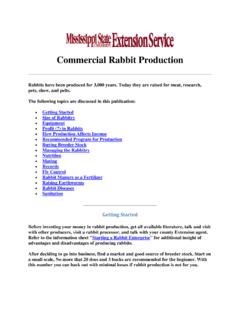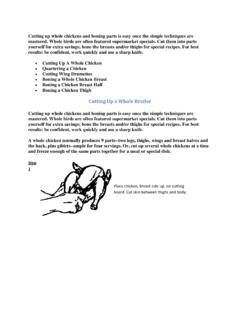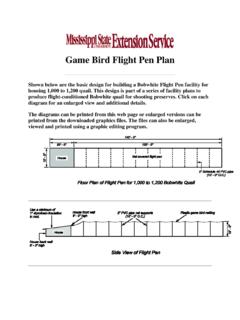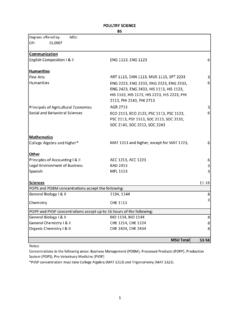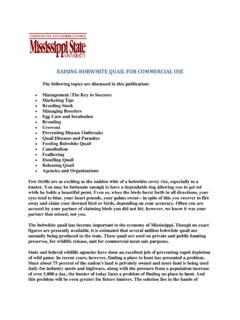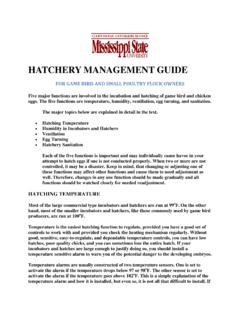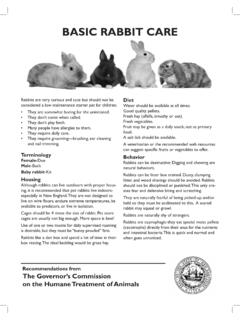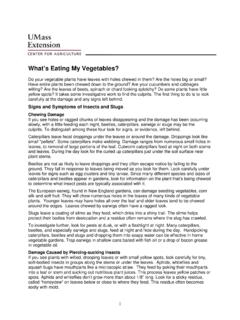Transcription of Slaughtering and Dressing Rabbits - Poultry Science
1 Slaughtering and Dressing Rabbits The following topics are discussed in this presentation: Meeting Legal Responsibilities Dressing Procedure Dressing Percentage rabbit Skins and Pelts Tanning Skins Meeting Legal Responsibilities If Rabbits are slaughtered for sale in commercial establishments (food stores, restaurants, etc), they must be processed in a manner that meets local or state health codes. These codes are usually established and enforced by state agencies, although community agencies may also have regulatory control. In most instances, meeting state requirements and Slaughtering with a "state license" is sufficient for sale of rabbit carcasses. Check with your local County Agent or state meat inspection agency for the policies that govern the processing and sale of Rabbits in your community. Dressing Procedure Rabbits are killed by one of two methods.
2 The preferred method is dislocation of the neck. The rabbit is held firmly by the rear legs and head; it is stretched full length. Then with a hard, sharp pull, the head is bent backward to dislocate the neck. The rabbit can also be struck a hard, quick blow to the skull behind the ears. A blunt stick or side of the hand is commonly used to incapacitate the rabbit . Both methods quickly render the rabbit unconscious. After dislocation or stunning, the rabbit is hung by one of the hind legs above the hock joint. The head is immediately removed to allow complete bleeding. The forefeet are then removed. The next step is to cut the skin around the hock joints of the legs and then to cut between these points across the lower part of the body. Remove the tail and pull the skin down and forward over the body. The skins of young or fryer age Rabbits are easily removed in this way; it is more difficult to remove the skins of older Rabbits .
3 If skins are saved for marketing, they should be handled as indicated in the rabbit Skins and Pelts section. After the head, forefeet and skin are removed, the carcass, while still hanging, is opened to remove the viscera. Make a cut from the lower part of the abdomen near the anus to the mid-point of the lowest rib. The intestinal tract and lungs are normally removed. Liver, kidneys, and heart remain with the carcass. Remove the carcass from the hanger and cut off the rear feet at the hock joint. Wash the carcass with clean, cold water to remove hair and any other soil or debris, and store it at a cold temperature, preferably at 35oF. and not over 40oF. Do not hold dressed carcasses for any length of time in water as they absorb excess moisture which becomes considered as a contaminant. When large numbers of Rabbits are to be slaughtered, the operation on an assembly line basis is much more rapid and efficient.
4 Dressed Rabbits may be sold whole or can be cut into parts. Various types of marketing devices (plastic cartons and trays) are available for packaging one or more carcasses. Dressing Percentage Dressing percentage is the relationship of the weight of a dressed carcass to the weight of the live animal, expressed as a percentage. The Dressing percentage varies depending upon the quality of the animal at slaughter, breed, age, amount of fat and the number of internal organs left with the carcass. Animals with good meat characteristics have a higher Dressing percentages than thin animals. Normally the liver, heart and kidneys remain with the carcass and are included in the carcass weight. Dressing Percentage of New Zealand and Dutch Rabbits at Different Ages Age New Zealand Dutch 8 weeks 13 weeks Mature Animals that are in average condition or slightly better than average have Dressing percentages of about 55 percent while good quality animals reach a Dressing percentage of 60 percent or higher.
5 The data shown above were obtained with New Zealand and Dutch Rabbits of different ages that were fed a commercial rabbit feed. The Dressing percentages of the Dutch were greater than those of the New Zealand, indicating breed variations. The percentage also increased between 8 and 13 weeks of age, but declined slightly in the mature Rabbits . Mature Rabbits in this study were limit-fed which may account in part for the lower Dressing percentages. Normally, Dressing percentage increases with age until Rabbits approach maturity. rabbit Skins and Pelts rabbit skins and pelts have been used for many years as fur, in the manufacture of felt, and for a variety of miscellaneous toys and other items. With the development of many synthetic fibers and imitation furs, the demand for pelts by furriers has decreased. Today there are few markets for furs in the United States.
6 Whether the pelts from meat Slaughtering should be saved and prepared for marketing will depend upon the market demand and value, the type and number of Rabbits being slaughtered and the time and facilities available for preparing the skins. It is unlikely that the small producer Slaughtering his own animals will find it economically worthwhile to process the skins. rabbit skins and pelts vary widely in quality and value. The different types of fur characteristics vary depending on the breed type. Skins from young of any breed are normally of poor quality and of less value than those from adult animals. Those with dense fur, that is not easily removed from the skin, are most desirable. Preparation of skins or pelts for market begins with the removal at slaughter. Exercised care to avoid cuts or tears, and remove body fat that often remains attached to the skin.
7 As the pelts are removed, turn them inside out while still warm and moist. Place them on wire stretchers or shapers with the front leg casings on one side. Shapers can be made from No. 9 gauge galvanized wire. The shapers extend or expand the pelts to their full length, but do not stretch them out of shape. Fasten the rear legs to the ends of the wire shapers with a clothes pins or some other fastener. Hang the pelts in a well-ventilated drying area, but not in direct sunlight. After the skins are dry the wire shaper is removed. Do not use salt or other chemicals on skins, but as they are being packed for storage or shipment, naphthalene (moth crystals) or paradichloro-benzene may be placed in the packaging container as an insect repellent. Tanning Skins Regardless of the method used for tanning, proper preparation of the skin is an important step.
8 This involves softening, removal of the adhering fat and flesh, and removal of oil in the skin. Open the skin with a midline cut along the ventral or belly side so that it can be stretched on a flat surface. Scrape adhering flesh and fat from the skin using a blunt knife or similar object. Removing all oil is essential for proper tanning. Working the skin in gasoline or other fat solvent is desirable to remove the last traces of fat. Dried skins are softened by soaking in several changes of water for about 1-3 hours. Time required for softening will vary; soaking time is kept to a minimum since excessive soaking tends to loosen the hair. Addition of borax or bicarbonate of soda (about 1 ounce per gallon) aids in softening, and a little soap or detergent aids in removal of the fat. Salt-Alum Tanning Prepare the solutions as follows: 1.
9 Dissolve 1 pound of ammonium aluminum sulfate or potassium aluminum sulfate (alum) in 1 gallon of water. 2. Dissolve 4 ounces of sodium carbonate and 8 ounces of sodium chloride (salt) in 1/2 gallon of water. 3. Slowly add the soda-salt solution to the alum solution with vigorous stirring. 4. Mix flour with the combined solutions to make a thin paste, first mixing the flour with a little water to aid in preventing lumps. Prepare the skins as previously described and stretched or tack to a flat surface. Coat the skin with a layer of the paste about 1/8" thick and cover lightly with paper or cloth. Allow skins to stand for about 24 hours, remove the paste, and apply a second coating. A third treatment may be required for thick skins. The last coating should remain for 3-4 days. Remove the paste and wash skins in a solution of borax or soda (1 ounce per gallon of water).
10 Squeeze out (do not wring) excess solution; rinse in plain water and squeeze out excess. Stretch, and when nearly dry, work the skin by rubbing and pulling over the edge of a table, as in polishing shoes with a cloth. Stretching and working the skin is necessary for softening the finished skin. If the skin is rough, it can be sanded with a coarse sandpaper block. A thin coating of neat's foot oil, glycerin, or other leather conditioner improves pliability. This process is considered slightly better than the salt-acid method that follows, but the finished product is usually harder and more working may be required to make it pliable. It may be necessary to resoak the skin, partially dry it, and repeat the rubbing in order to make it more pliable. Tanning is also accomplished by soaking skins for 2-4 days in the solution before addition of flour.
